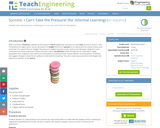
Students learn about pressure, employing it to crush cans and model the atmosphere.
- Subject:
- Engineering and Information Technologies
- Material Type:
- Lesson Plan
- Provider:
- TeachEngineering
- Provider Set:
- TeachEngineering
- Date Added:
- 10/14/2015

Students learn about pressure, employing it to crush cans and model the atmosphere.
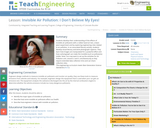
Students develop their understanding of the effects of invisible air pollutants with a rubber band air test, a bean plant experiment and by exploring engineering roles related to air pollution. In an associated literacy activity, students develop visual literacy and write photograph captions. They learn how images are manipulated for a powerful effect and how a photograph can make the invisible (such as pollutants) visible. Note: You may want to set up the activities for Air Pollution unit, Lessons 2 and 3, simultaneously as they require extended data collection time and can share collection sites.
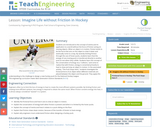
Students are introduced to the concept of inertia and its application to a world without the force of friction acting on moving objects. When an object is in motion, friction tends to be the force that acts on this object to slow it down and eventually come to a stop. By severely limiting friction through the use of the hover pucks, students learn that the energy of one moving puck is transferred directly to another puck at rest when they collide. Students learn the concept of the conservation of energy via a "collision," and will realize that with friction, energy is converted primarily to heat to slow and stop an object in motion. In the associated activity, "The Puck Stops Here," students will investigate the frictional force of an object when different materials are placed between the object and the ground. This understanding will be used to design a new hockey puck for the National Hockey League.
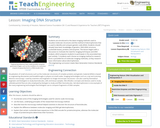
Students are introduced to the latest imaging methods used to visualize molecular structures and the method of electrophoresis that is used to identify and compare genetic code (DNA). Students should already have basic knowledge of genetics, DNA (DNA structure, nucleotide bases), proteins and enzymes. The lesson begins with a discussion to motivate the need for imaging techniques and DNA analysis, which prepares students to participate in the associated two-part activity: 1) students each choose an imaging method to research (from a provided list of molecular imaging methods), 2) they research basic information about electrophoresis.
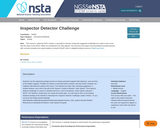
Students use the engineering design process to design and build magnetic-field detectors, and use them to find hidden magnets. Parallels are drawn to real-world NASA missions and how NASA scientists use magnetic field data from planets and moons. The website has video clips, teaching suggestions, a student handout, and a link to the pdf of the Teachers Guide for Mission: Solar System. The Inspector Detector challenge is a series of activities that form a unit in the Mission: Solar System collection. * NOTE: The Teachers Guide does not contain the lesson plan. You will need to click on the Student Handout heading of the website to download the Inspector Detector Challenge Leaders Notes.
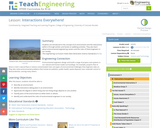
Students are introduced to the concept of an environment and the interactions within it through written and hands-on webbing activities. They also learn about environmental engineering careers and the roles of these engineers in our society.
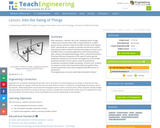
After watching a 1940 film clip of the "Galloping Gertie" bridge collapse and a teacher demo with a simple pendulum, student groups discuss and then research the idea of motion that repeats itself specifically the concepts of periodic and harmonic motion. They become aware of where and how these types of motion occur and affect them in everyday applications, both natural (seasons, tides, waves) and engineered (swings, clocks, mechanical systems). They learn the basic properties of this type of motion (period, amplitude, frequency) and how the rearrangement of the simple pendulum equation can be used to solve for gravitational acceleration, pendulum length and gravity. At lesson end, students are ready to conduct the associated activity during which they conduct experiments that utilize swinging Android® devices as pendulums.

Presentation of class rules, vocaublary, and review of year one scope and sequence.
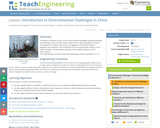
Through an overview of some of the environmental challenges facing the growing and evolving country of China today, students learn about the effects of indoor and outdoor air pollution that China is struggling to curb with the help of engineers and scientists. This includes the sources of particulate matter 2.5 and carbon dioxide, and air pollution impacts on the health of people and the environment.
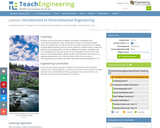
Students are presented with examples of the types of problems that environmental engineers solve, specifically focusing on air and land quality issues. Air quality topics include air pollution sources, results of poor air quality including global warming, acid rain and air pollution, as well as ways to reduce air pollution. Land quality topics include the differences between renewable and non-renewable resources, the results of non-renewable resource misuse and ways to reduce land pollution. (Water quality is introduced in a later lesson in a separate presentation, as it is the focal point of this unit curriculum.)
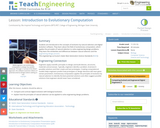
Students are introduced to the concepts of evolution by natural selection and digital evolution software. They learn about the field of evolutionary computation, which applies the principles of natural selection to solve engineering design problems. They learn the similarities and differences between natural selection and the engineering design process.
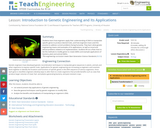
Students learn how engineers apply their understanding of DNA to manipulate specific genes to produce desired traits, and how engineers have used this practice to address current problems facing humanity. They learn what genetic engineering means and examples of its applications, as well as moral and ethical problems related to its implementation. Students fill out a flow chart to list the methods to modify genes to create GMOs and example applications of bacteria, plant and animal GMOs.
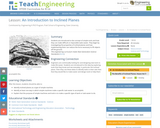
Students are introduced to the concept of simple tools and how they can make difficult or impossible tasks easier. They begin by investigating the properties of inclined planes and how implementing them can reduce the force necessary to lift objects off the ground.
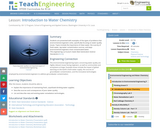
Students are presented with examples of the types of problems that environmental engineers solve, specifically focusing on water quality issues. Topics include the importance of clean water, the scarcity of fresh water, tap water contamination sources, and ways environmental engineers treat contaminated water.
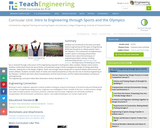
Students are introduced to the basic principles behind engineering and the types of engineering while learning about a popular topic - the Olympics. The involvement of engineering in modern sports is amazing and pervasive. Students learn about the techniques of engineering problem solving, including brainstorming and the engineering design process. The importance of thinking out of the box is stressed through a discussion of the engineering required to build grand, often complex, Olympic event centers. Students review what they know about kinetic and potential energy as they investigate the design of energy-absorbing materials, relating this to the design of lighter, faster and stronger sporting equipment to improve athletic performance and protect athletes. Students consider states of matter and material properties as they see the role of chemical engineering in the Olympics. Students also learn about transportation and the environment, the relationship between architecture and environment, and the relationship between architecture and engineering.
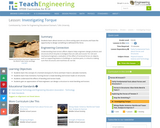
This lesson focuses on torsion as a force acting upon structures. Students will have the opportunity to design something to withstand this force.
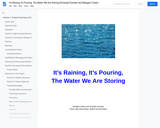
Our students will be studying and exploring the human impact on groundwater. They will study the water deprivation impacts both locally and in the San Joaquin Valley. Students will explore and come to understand the benefits of collecting rainwater. We partnered with the City of Eugene and had the wonderful Jackie come in. Our students brought in many of the materials including cardboard boxes, empty plastic containers (sour cream, water bottles,etc), tin foil, wax paper, duct tape,etc. We as teachers provided the underground sprinkler tubing cutting material, more tape and supplies. We tested this project with our 5th graders so we could make improvements and continue this project next year. In order to complete this project, we needed a full three weeks of working for an hour plus every day. We incorporated this project into our reading and science timeline.
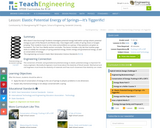
Students investigate potential energy held within springs (elastic potential energy) as part of the Research and Revise step. Class begins with a video of spring shoes or bungee jumping. Then students move on into notes and problems as a group. A few questions are given as homework. The Test Your Mettle section concludes. The lesson includes a dry lab that involves pogo sticks to solidify the concepts of spring potential energy, kinetic energy and gravitational energy, as well as conservation of energy.
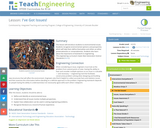
This lesson will introduce students to environmental issues. Students will recognize environmental opinions and perspective, which will help them define themselves and others as either preservationists or conservationists. Students also learn about the importance of teamwork in engineering.
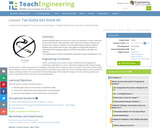
Students identify types and sources of indoor air pollutants in their school and home environments. They evaluate actions that can be taken to reduce and prevent poor indoor air quality. In an associated literacy activity, students develop a persuasive peer-to-peer case against smoking with the goal to understand how language usage can influence perception, attitudes and behavior.